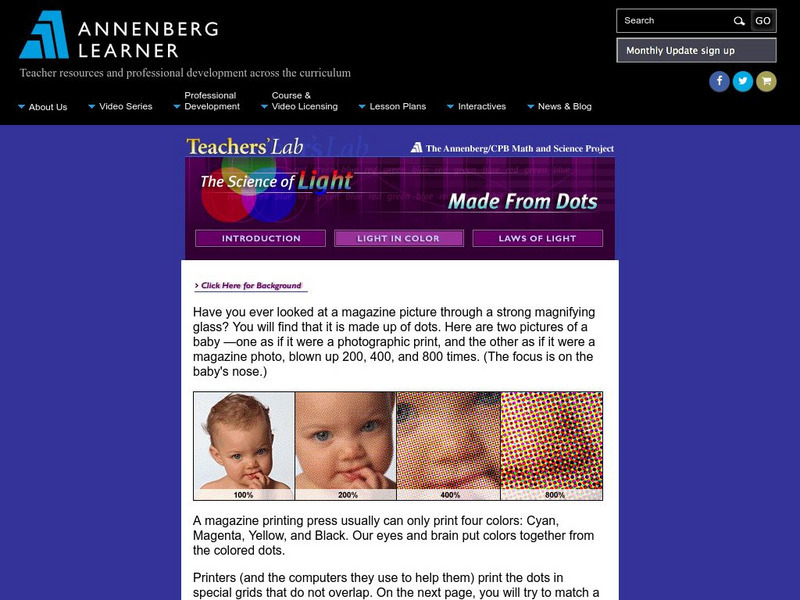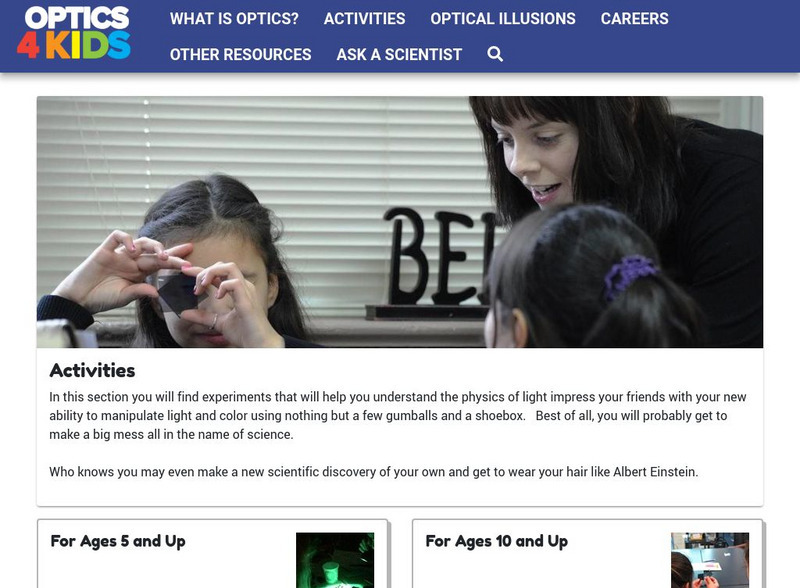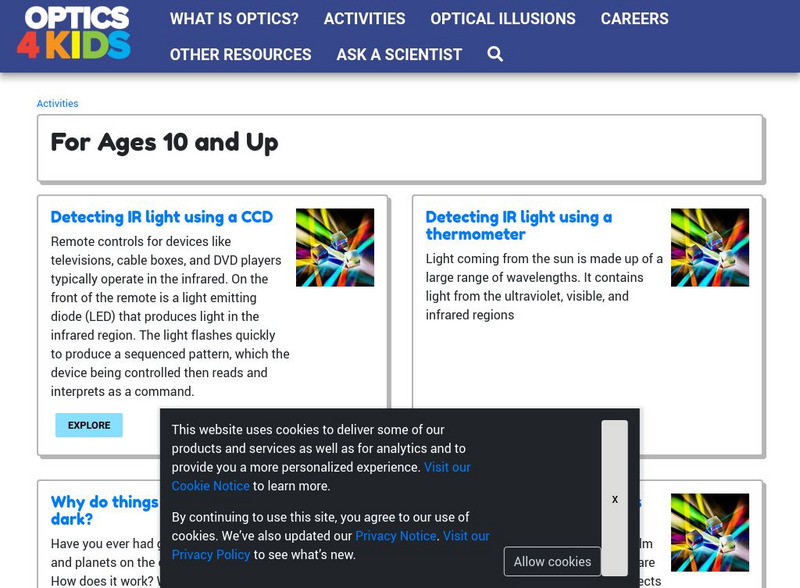TeachEngineering
Teach Engineering: Learning Light's Properties
Students learn the basic properties of light--the concepts of light absorption, transmission, reflection and refraction, as well as the behavior of light during interference. Lecture information briefly addresses the electromagnetic...
TeachEngineering
Teach Engineering: Laser Types and Uses
Through two classroom demos, students are introduced to the basic properties of lasers through various mediums. In the Making an Electric Pickle demonstration, students see how cellular tissue is able to conduct electricity, and how this...
TeachEngineering
Teach Engineering: Security System Design
Middle schoolers apply everything they have learned about light properties and laser technologies to designing, constructing and presenting laser-based security systems that protect the school's mummified troll. In the associated...
NASA
Nasa: Optics: Light, Color, and Their Uses
Download this Educators Guide to light, color, and their uses. Choose from different activities using lenses, prisms, hidden messages, periscopes, and kaleidoscopes
Physics Classroom
The Physics Classroom: Wavelike Behaviors of Light
How light waves demonstrate their wave nature by reflection, refraction, and diffraction.
Stanford University
Stanford Encyclopedia of Philosophy: Divine Illumination
Excellent article from the Stanford Encyclopedia of Philosophy tracing the development of "divine illumination" throughout the classical and medieval Christian philosophical tradition. Describes how this distinctively Christian...
ClassFlow
Class Flow: What Is Light?
[Free Registration/Login Required] This flipchart reviews the characteristics of light and its properties. Students are given examples of reflection, refraction, and lens types. An assessment component is included.
Utah Education Network
Uen: Enlightening Explorations
This lesson engages students in making observations about different features of light. Students will circulate in different light stations, reflect on what they have observed, and then write about what they learned.
Utah Education Network
Uen: I'm So Bright! I Wear My Shades Indoors!
This lesson engages students in learning about light through multiple sources. Students will learn how light is produced, reflected, refracted, and separated. Students will communicate their findings through an independent project that...
Utah Education Network
Uen: Enlightening Explorations, Part Iii
This lesson contains the following labs: Rainbows, Refraction with Prisms, and What Color Is It? Students will study light by reading various nonfiction texts and viewing a video lesson. Then students will engage in the following labs:...
Utah Education Network
Uen: Enlightening Explorations, Part Ii
This lesson engages students in learning about light. Studets will describe how light is produced, reflected, refracted, and separated.
Physics Classroom
The Physics Classroom: Light Waves and Color
The behavior of light waves is introduced and discussed. Also, polarization, color, diffraction, and interference are introduced and discussed thoroughly as supporting evidence of the wave nature of light.
Stanford University
Stanford University: Conventionality of Simultaneity
This site from Stanford University is on the topic of simultaneity in relativity.
Sophia Learning
Sophia: Physics: Bill Nye: Bending Light
Created to teach students of the 21st century, SOPHIA is bringing science experiments straight to your fingertips. Become the commander of your own learning experiences as you take part in this interactive experiment.
Annenberg Foundation
Annenberg Learner: Made From Dots
Notice how magazines print photos using dots made up of percentages of only three colors and black. Try your hand at using percentages of cyan, magenta and yellow to match the magazine color displayed.
University of Colorado
University of Colorado: Physics 2000: Electromagnetic Waves
Using a student-teacher dialogue format, this page discusses the nature of light as an electromagnetic wave and the electromagnetic spectrum.
National Gallery of Art
National Gallery of Art: American Impressionists
This site provides many examples of American Impressionistic work. Also, under the section titled "Overview", it gives information into the origins of American Impressionism (click the "continued" link after the paragraph).
Other
American Coal Foundation:lesson Plan:how Much Does It Cost to Light the School?
Lesson explores where electricity comes from, how much it costs, and the amount of coal that is used. Learners will relate these concepts to how much coal is needed to light their school/classroom for one hour.
Utah State Office of Education
Utah State Office of Education: Force, Energy, & Motion
A unit on energy, force, and motion presented with interactive and classroom activities. Students gain an understanding of weight, mass, potential and kinetic energy, sound, and heat with this engaging resource.
Optical Society
Optical Society of America: Exploring the Science of Light: Easy Activities
A collection of simple experiments for exploring the basic properties of light and color.
Globio
Glossopedia: Light
Light is a form of energy. We see it in many different forms all around us. It's the sunlight that pours through your bedroom window and wakes you up. Images and in-depth information on light can all be accessed in this article.
Other
Girl Scouts of the Usa: Lighten Up! Discovering the Science of Light [Pdf]
A 36-page booklet of activities and experiments for exploring the properties of and nature of light. Includes a section on careers in optics. As this is a Girl Scouts booklet, it was created with girls in mind, but would be equally...
Optical Society
Optical Society of America: Exploring Science of Light: Intermediate Activities
A collection of intermediate experiments, for students aged ten and up, for exploring the magnification, reflection, and refraction of light.
South Carolina Educational Television
Etv: Nasa Online: Light: Atmosphere
An interactive look at our atmosphere and factors which affect planet Earth. NASA measurements of volcanic eruptions, toxic emissions, aerosols, and wind patterns are all graphically displayed. Basic text plus bold visuals make this...





















